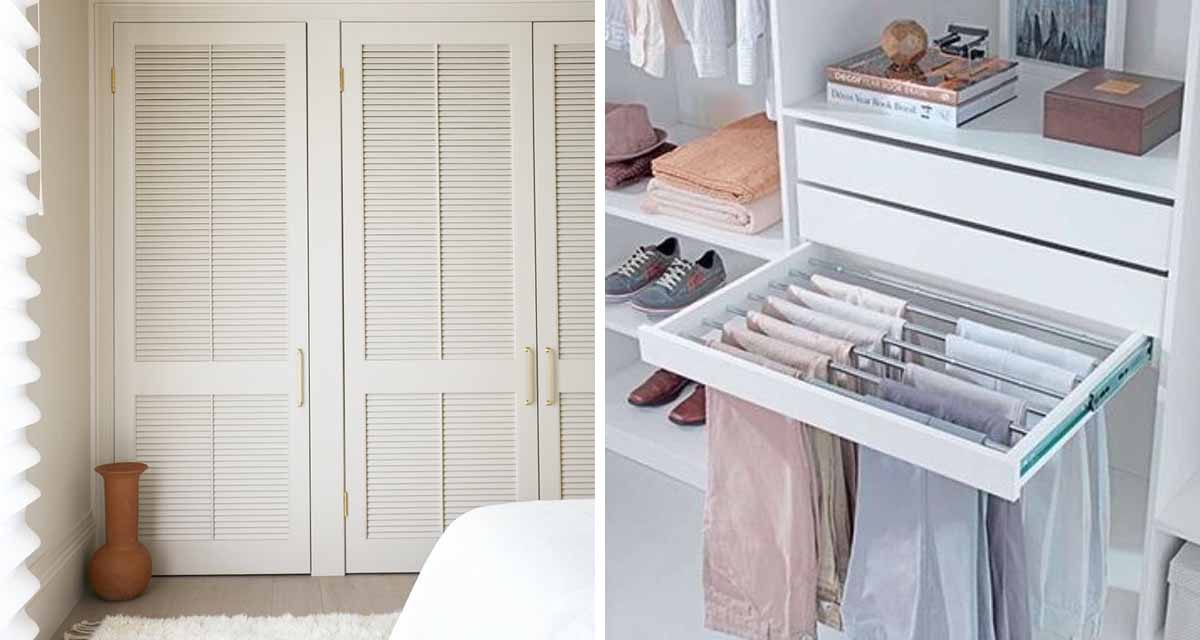Whether you’re renovating an existing bedroom or moving into a new home, we know that a carefully planned and designed wardrobe is high on our clients priority lists.
It’s also an area of design that we love. We get a real kick out of designing storage, because it encompasses both our love of design and organisation. Two of our favourite OCD things in life.
Truth Bomb. When it comes to designing wardrobes for your bedroom, there is a lot of reality to the process that often doesn’t align with the pretty pictures we see on Pinterest and Instagram. Sure wouldn’t we all love a beautiful walk in wardrobe, with plenty of display space for every little item that we own. However for most of us a wardrobe consists of a row of cupboards along one wall in our bedroom – and a long wall if we are lucky enough.
Regardless of the layout and size of your wardrobe there are a couple of key factors you need to consider during your wardrobe planning process, so that you can personalise your space as best you can.
Do you hang or fold?
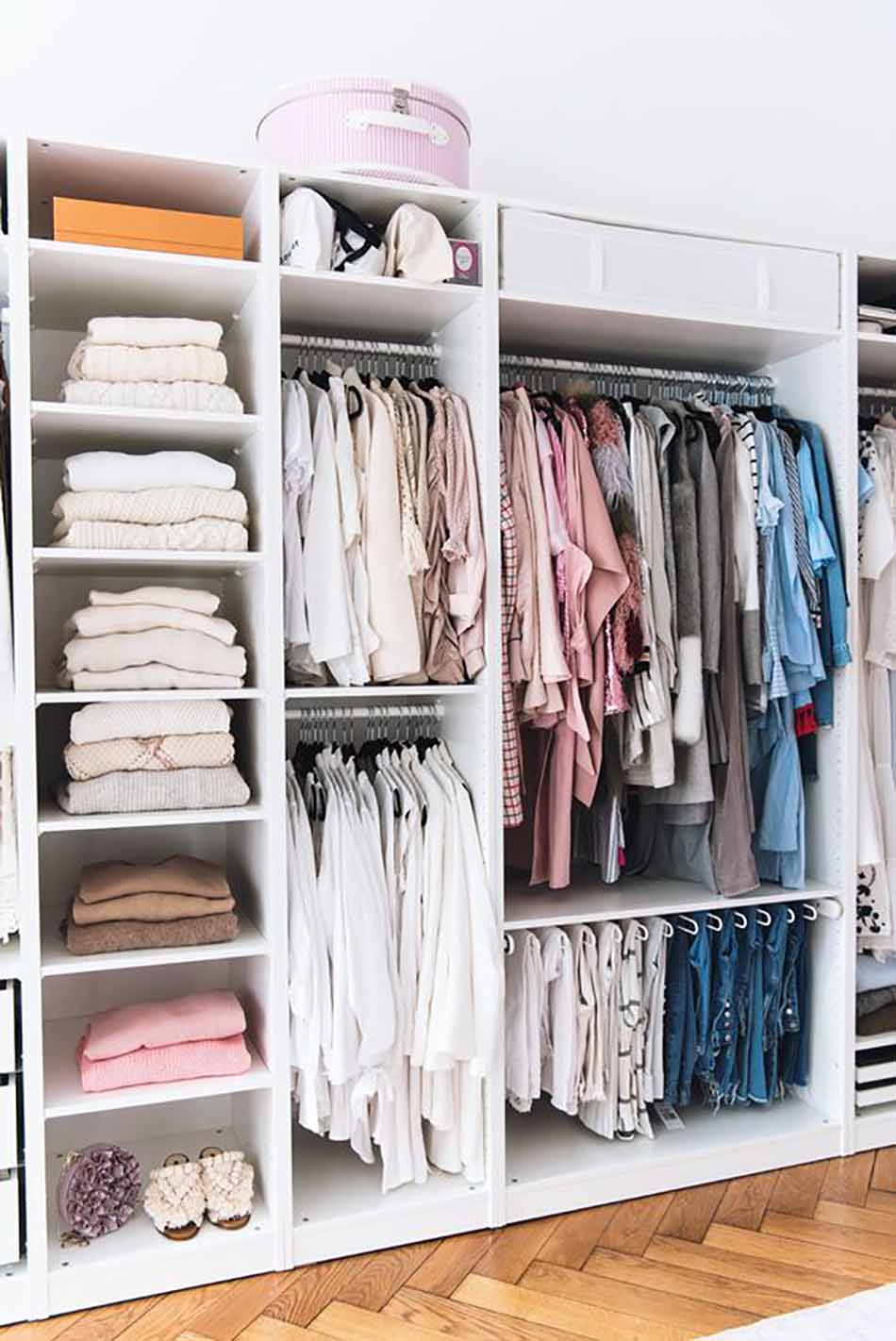 Image via Pinterest
Image via Pinterest
One of the first question we ask our clients is whether they like to hang their clothes up, or whether they prefer to fold them. Knowing how much hanging space we need to incorporate into a wardrobe, versus shelving, is step one in our layout planning.
In generic wardrobe setups there is a mix of both, however we know that it’s important to think through this question a little more.
My personal preference is for hanging pretty much everything I can. This visual arrangement makes me feel like my cupboard is more organised – and lets be honest, it’s much easier to keep your clothes tidy on a hangar than it is to have them neatly folded on top of each other. I hang everything from singlets, to tank tops, shirts, skirts, dresses, trousers, hoodies, jackets etc. Even if I have knitted tops or dresses, I will still hang them rather than fold them.
We also consider hanging lengths at this stage. If you’re a maxi dress kind of gal, we need to incorporate longer hanging spaces for your dress selection.
For men, the opposite is often true. The housemate, for example, would rather fold as much as he can. Only his trousers, larger hoodies and a few t-shirts hang up – and that’s only because I insist on hanging some of those tops up.
Shelves or drawers?
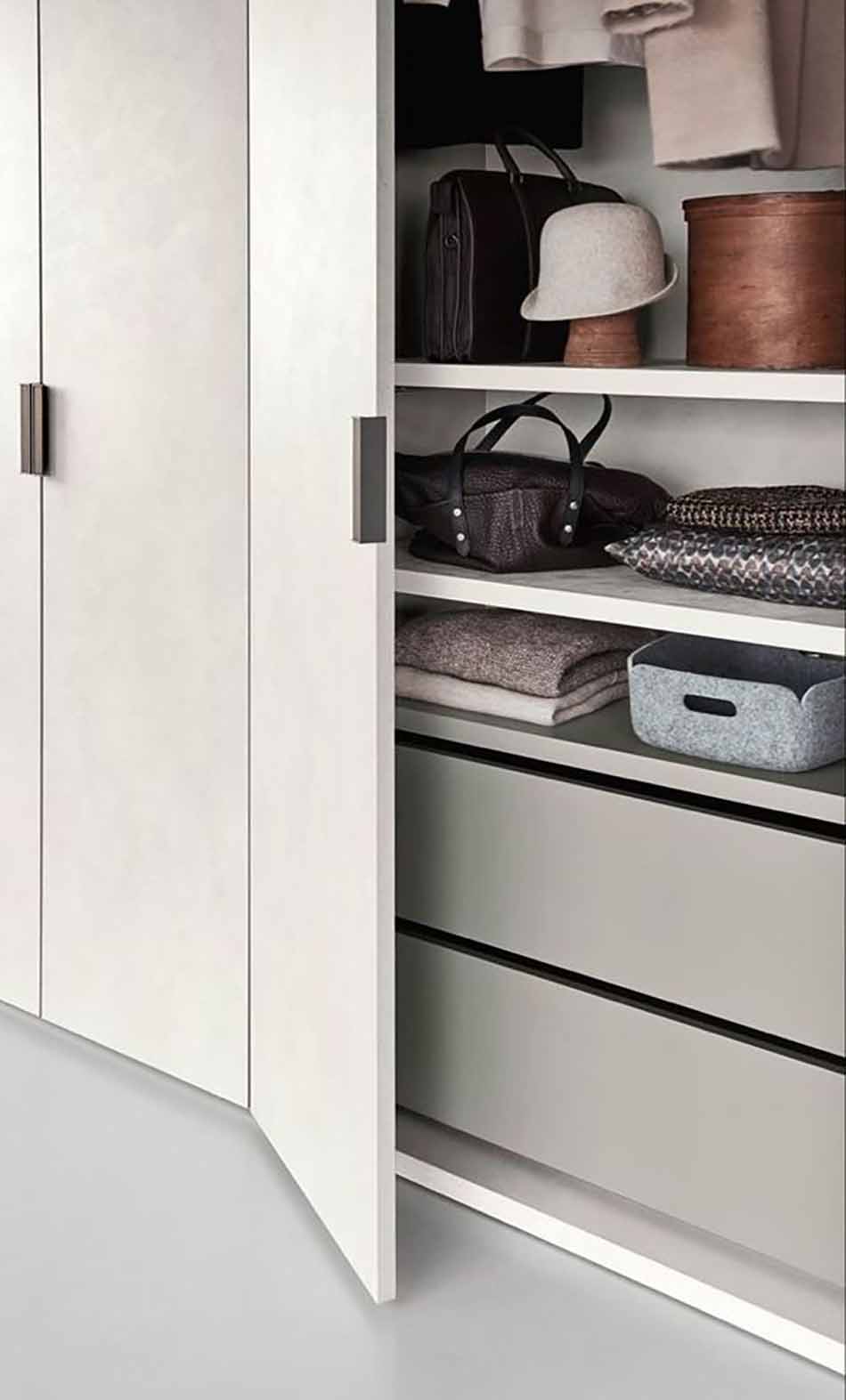 Images via Pinterest
Images via Pinterest
Once we’ve established what you prefer to hang and fold, we then talk open shelves versus drawers. For the most part when it comes to folding I prefer closed drawers to open shelves. Shelves are considered a preference for items that are used more frequently and sit higher in the cupboard, while drawers are for concealing items and lower parts of the wardrobe.
From a budget perspective shelves are far more cost effective are there is no hardware involved, but trying to access an open shelf at the bottom of a cupboard is the pits, and at the very least we also try to make the bottom row or two drawers rather than shelves.
We typically assign drawers for lingerie and socks, sleepwear and sports clothes. I also use drawers for my jerseys and shorts. Now this may not work for jersey lovers, who will want to see their beautiful collection on full display. As a person I don’t wear a lot of jerseys. I prefer fitted tops and jackets, and these all get placed on hangars. The jerseys I do wear, are usually longer cardigan type of styles, and quite honestly I don’t like how they fold and I also don’t like to see them every time I open my cupboards, so they go into drawers.
The same applies to my shorts, which I wear a lot of. I do think it is worth hanging ‘smart’ shorts alongside your trousers, as it’s great for creases and keeping them looking good. However for your more casual selection of shorts, a shelf or drawers is the way to to go. I prefer not to fold my shorts, but rather just lay them flat on top of each other, but I’m not sure how MK (Marie Kondo FYI) would feel about that.
Where do my accessories go?
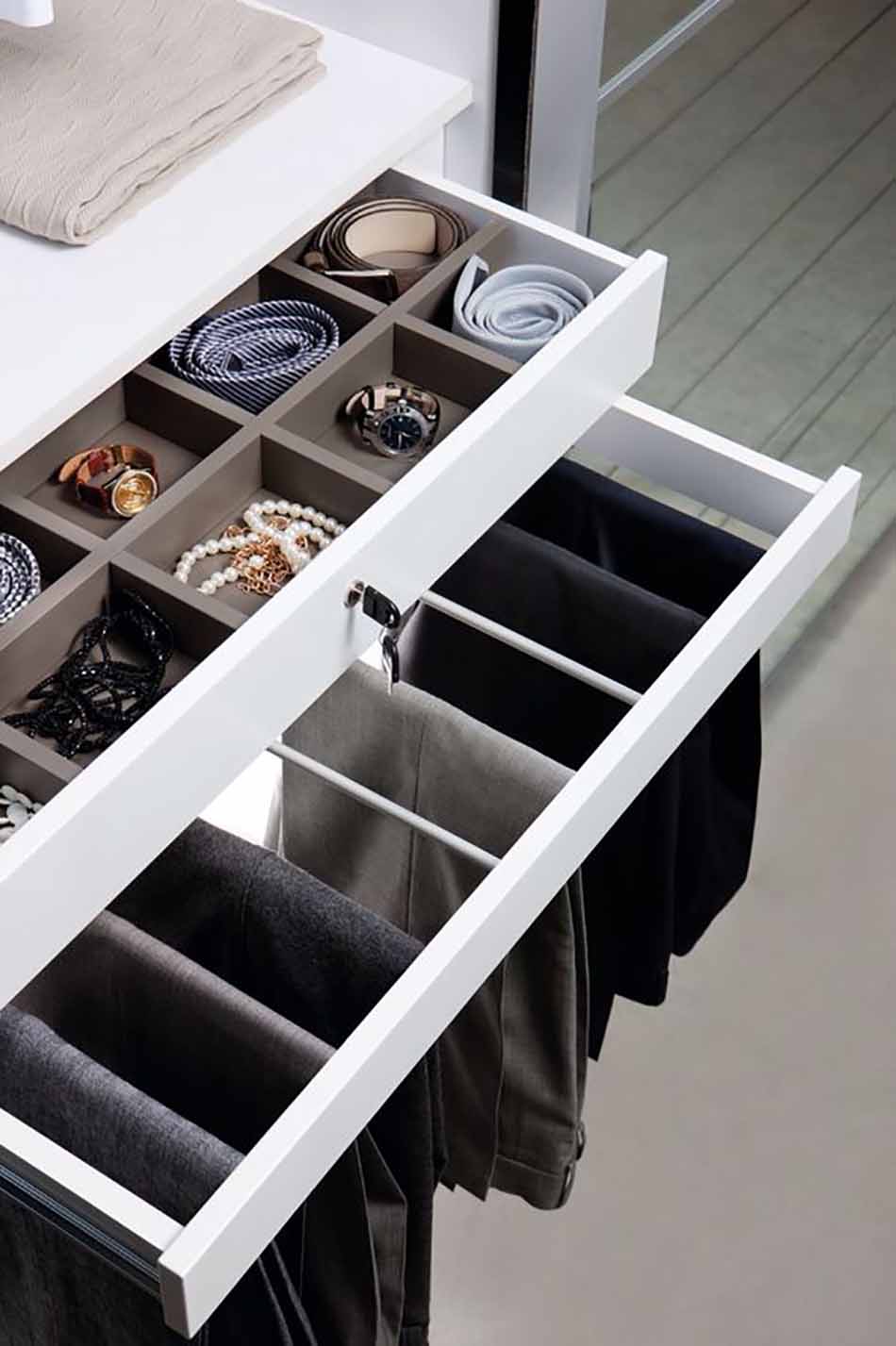 Image via Pinterest
Image via Pinterest
Once we’ve gone through the majority of your clothing, we focus on the accessories, with shoes being the big one.
Here again we need to do a recon on what you own. Are you a sneaker head or is it heels all the way? Boots require height discussions for proper storage, especially as they can vary in height so much. We read a stat the other day – the average woman has 40 pairs of shoes, compared to the average man who owns 10 pairs of shoes. Wow! I was too scared to count this myself, but I believe it!!!
From a space planning perspective, more shoes can fit on a flat shelf (stored heel to toe for maximum efficiency), however I prefer shoe hatches so that we can maximise the vertical space rather than the horizontal space.
Shoes, bags, hats, and personal items like jewellery are all discussed at this time, as well as priorities in storage. Since we are constrained by the size limits of the space, not everything is going to get its own personal hatch, so we need to know which items you are happy to place together as a space saving measure.
Mirror mirror on the wall
 Image via Est Living
Image via Est Living
This could seem counter-intuitive to many people, but we like to advise our clients not to have a vanity and makeup station within their wardrobe design. Why? Space is the number one reason.
If you have an uninterrupted section of wall that we can dedicate to your wardrobe design, we will. A dedicated vanity section will take away valuable real estate from your wardrobe design. Vanity units can also be a beautiful pieces of standalone furniture, so incorporating them into your wardrobe can be a wasted opportunity.
They are also small enough to be placed in another area of the bedroom, or even better, we can take it to the bathroom. Especially for makeup, which can be messy and often requires you to wash your hands during the process.
Layout
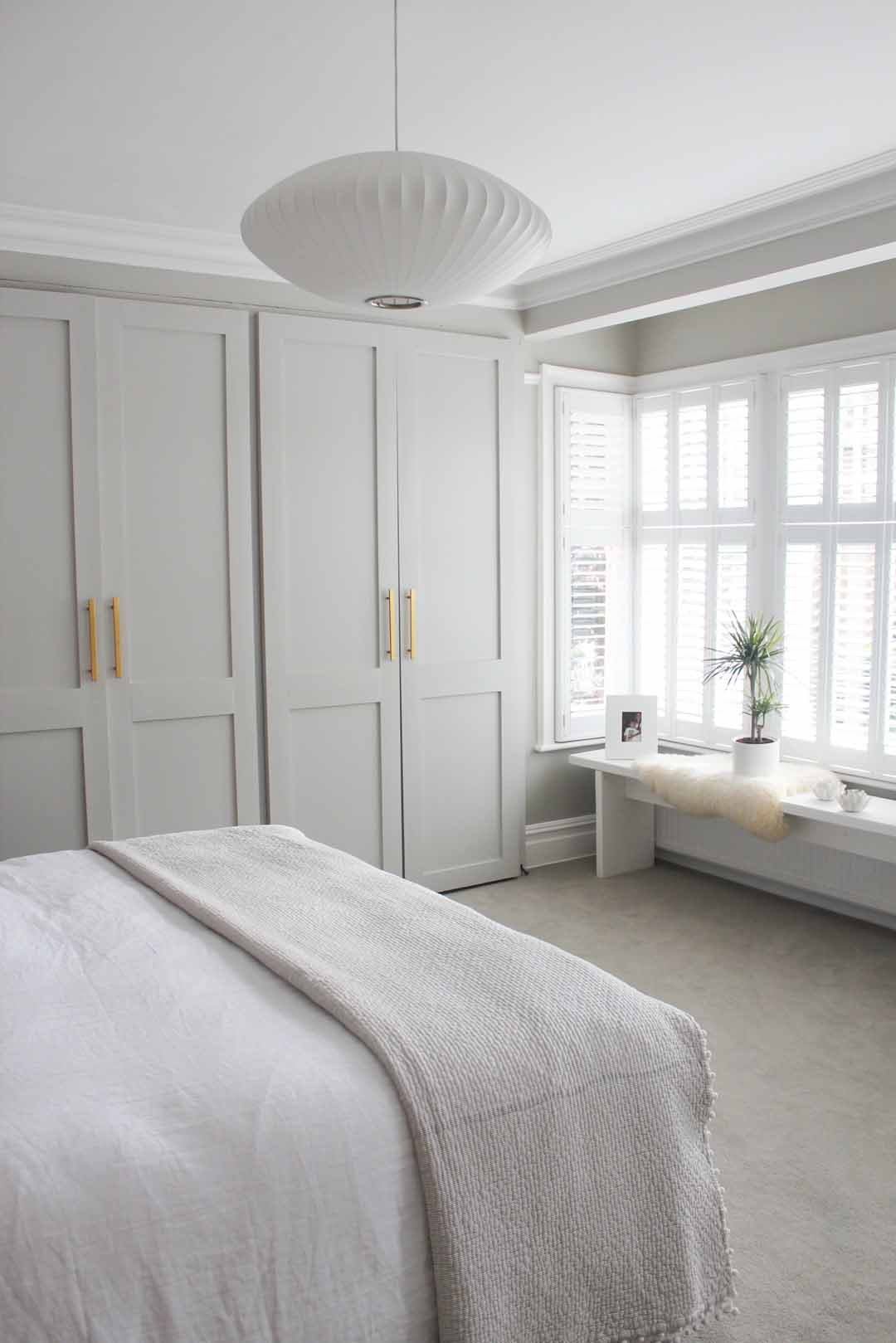 Image via Aneli Bluch
Image via Aneli Bluch
Having gone through what you own and what your storage priorities are, we then move onto the layout planning. With every wardrobe I like to create the “main” wardrobe and the “secondary” wardrobe. The main wardrobe is for all your daily clothes – the stuff you love and wear the most. Those items you wear out of the house.
The secondary wardrobe contains all your hard working clothes – your sports gear, your slouch around the home and lounge wear collection, your collection of hoodies that perhaps you can’t get rid of but you will never wear in public.
The if you have the space and the clothes, we also like to have a wardrobe dedicated to jackets only. For the really big winter jackets that always take up too much space. These guys require a whole hanging section on their own.
We love this approach to separating the functional elements of your wardrobe, as it works towards elevating the overall feeling of your clothing. Whether you’re a fashionista or not, you’ve spent money on these clothes and it’s what you feel good in, so we like to take care of them.
For the most part, we try not to take a seasonal approach to wardrobe design. We like to have everything contained in one space and having it visible throughout the year. Since we are big on the Less is More front, we also believe this helps you contain your wardrobe size and helps you realise that you can in fact have too much stuff.
The Look and Feel
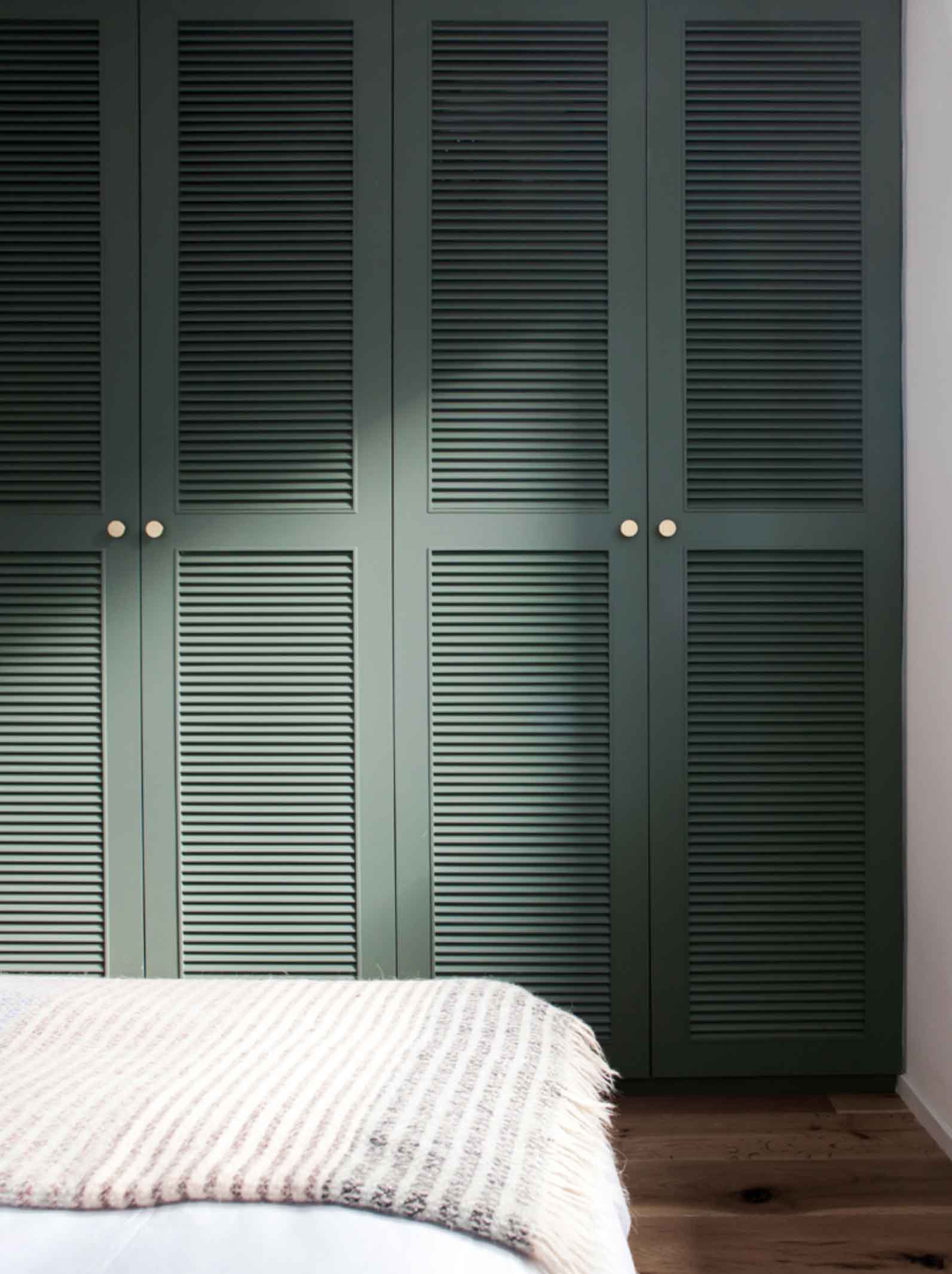 Image via Design Boom
Image via Design Boom
Other elements to consider is lighting for your wardrobe. On the top end of the scale you can have LED lights incorporated into the design of your wardrobe, so that every time you open the door there is soft low lighting emanating from inside the wardrobe.
For the most part, good lighting comes down to have enough lighting in your bedroom to adequately light up your wardrobe interiors.
Choosing the overall look and feel for your wardrobe is very much related to the style and colour palette of your home, and specifically your bedroom. We always suggest choosing a colour that you are more likely to feel comfortable with in the long run.
White is the obvious choice for many. We also love a soft grey interior for a slightly lux feeling without been too dark. Wood finished wardrobes are gorgeous to look at. My personal view is that the clothes don’t look as good against the wood backdrop as they do against white or light grey. I cannot tell you why I feel this, but I simply would never have a wood finished wardrobe myself.
Since cupboards doors are high use items, we do prefer to put a handle on them.
No doubt you’ve heard the sentiment that it’s only what’s inside that counts. Clearly that phrase isn’t referring to closet doors!
If you feel your wardrobe needs a makeover, inside or out, we recommend updating basic details, such as the cupboard doors, finish details, handles or colour. This is a simple way to elevate the overall style of any closet without having to replace the entire unit. Look for inspiration in our Not Your Average Closet Doors post.
These small but important finishing details are how you personalise your units to suit your bedroom.
If you are having trouble creating your own customised wardrobe, contact us on projects@thehomestudio.co.za to arrange a personal design consultation.


